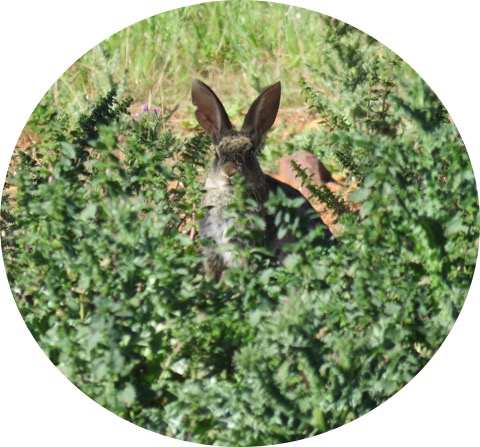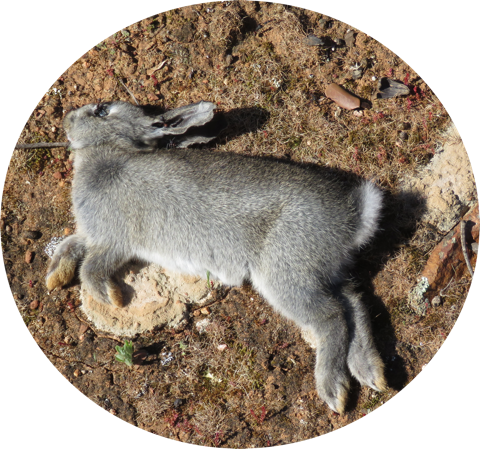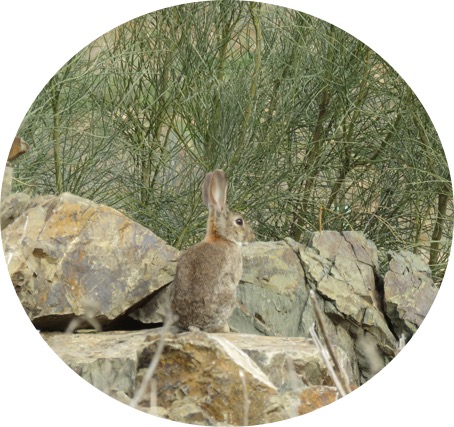THREATS
The causes of mortality
Over the past 70 years Iberian rabbit numbers have fallen by over 90% due to changes in land use and the spread of diseases. Based on the data analysed in the last evaluation, the International Union for Conservation of Nature (IUCN) classified the status of the rabbit in the Iberian Peninsula as “Endangered”.
The rabbit was once very abundant in the Iberian Peninsula but the effects of two viral diseases, myxomatosis and viral haemorrhagic disease (VHD), have seriously harmed its populations
Another factor that has hit rabbit populations hard is the degradation of its habitat. Even before the appearance of VHD, changes in land use, the abandoning of traditional techniques for scrub management, agricultural intensification in certain areas of the Iberian Peninsula, and land consolidation all negatively affected rabbit populations.

DISEASES
MYXOMATOSIS
Although this disease has become endemic, its virulence decreases progressively over time. It still kills rabbits directly but also affects them indirectly in other more serious ways by rendering sick animals incapable of defending themselves against predators or even searching for food. Infected rabbits are also highly vulnerable to other infections since myxomatosis provokes severe immunodepression and facilitates the appearance of secondary infectious diseases.

This disease first appeared in Spain in 1953 and began to spread the following year reaching almost all Spanish provinces by 1955 and causing high mortality rates. It is caused by infection by a virus – myxomavirus; Poxviridae – that is transmitted by direct contact between animals. Nevertheless, the most effective means of transmission in the wild is via fleas or mosquitos that bite infected rabbits and then transmit the disease to other individuals when they bite them. Contrary to popular belief, ticks do not transmit myxomatosis.
Myxomatosis is most prevalent when fleas and mosquitos are most abundant and most active: spring in the former case and at the end of summer in the latter.
This disease causes swellings of the skin, which grow as the virus spreads through the bloodstream causing secondary swellings, above all on the head and eyelashes, as well as a characteristic milky discharge from the eyes that occurs in rabbits of all ages. Nevertheless, affected adults tend to develop chronic but less virulent forms. Young rabbits, on the other hand, become seriously ill and death rates are high, the exception being very young rabbits who acquire antibodies via their mother’s milk and remain partially immune. Immunity can also be acquired genetically when females mate with immune males whose immunity is then passed on to their descendants.
In populations with a large number of young rabbits, myxomatosis can kill over 50% of all rabbits.
VIRAL HAEMORRHAGE DISEASE (VHD)

This disease appeared in the Iberian Peninsula in the 1980s and death rates of 50–80% occurred in populations previous affected by myxomatosis. Recent studies indicate that in the centre-south of Spain the decline in populations affected by VHD is still at 73.4% compared to populations studied after the outbreak of the disease (Delibes-Mateo et. al 2008).
The main symptoms of this disease are internal and chiefly affect the liver, and, depending on the severity of the infection, can quickly kill an affected rabbit. The external symptoms are, unlike myxomatosis, less obvious but occasionally include nasal and anal haemorrhages.
Young, week-old rabbits are practically immune to this disease while almost all infected adults die. Currently, however, as new strains appear, both adults and young are now being affected in spring (since 2012). This is a radical change and it is probable that natural immunity no longer exists. Although rabbits can become immune via their mother’s milk or by developing and then overcoming the disease, this immunity is not permanent and only lasts 6–8 weeks in the former case and up to a year in the latter.
In 2011–2012 a new strain was detected in Spain and Portugal that was different from the classic VHD. This strain also affects young rabbits and kittens even if they are immune to the classic strain. The mortality rates associated with this new strain are high and have halted the recuperation of the rabbit populations that once seemed to be well on their way to recovery.
Despite the efforts made thus far, many questions remain unanswered regarding how this disease is transmitted, how it operates and is spread, and the role played by disease vectors and reservoirs. Possible factors in the spread of the virus include the role played by avian scavengers and predators, by mammals that transport the virus after consuming affected rabbits, and by the human-induced translation of rabbits.
PREDATION
Rabbits have a high rate of appetite, which is why they constitute a more or less important part of the diet of a large number of carnivorous mammals and birds of prey. In general, generalist predators consume a low percentage of rabbits, while specialists do so in very high proportions.

The highest mortality is suffered by young specimens, followed by kits and finally adults. Juvenile mortality is therefore a real bottleneck for rabbit populations. In this sense, it is important to point out that rabbits suffer important losses in the breeding season, when the newborn rabbits remain in the rabbit holes that the mother digs inside the main nursery or its surroundings. Breeding burrows are actively searched by predators such as fox, wild boar or reptile species, which access the chambers by digging.
Predation is a natural phenomenon, so equilibrium conditions do not pose a risk to the maintenance of the population. However, the increase in generalist predators, added to the deterioration of the habitat in some areas of the Iberian Peninsula and the impact of the previously mentioned diseases, have placed many populations at very low levels of abundance. In these cases, predation does act as a limiting factor in the recovery of abundance levels and forms what has been called the “predation trap or well”.
IMBALANCE OF THE ECOSYSTEM
There are numerous publications that have studied the relationships between the rabbit and its habitat, as well as between the rabbit and other species – whether they compete for food, or as a prey.
The availability of adequate shelter, water and quality food are the factors that determine the quality of the habitat for the rabbit. As we have seen, shelter is provided by deep, soft and easily excavated soils. The availability of shelter appears to be one of the key factors in population density.
The habitat, in addition to shelter, must provide water and food. Rabbits need quality protein and water that they get from eating green growing grass. Abundant and good quality food, diverse and with species that present different cycles of germination and growth, allows rabbits longer and more productive breeding periods.
The optimum habitat model that the wild rabbit would need was described in 1993 and would present the following characteristics:
- It would be located in the southern half of the Iberian Peninsula, with an altitude of less than 900m and would have a typically Mediterranean climate. The terrain would be slightly undulating and without great slopes. Soils should be soft to allow burrowing.
- The general physiognomy of the land would be similar to a dehesa: with abundant patches of scrub that provide effective cover for the rabbit. Tree cover would be low, around 25%, without being decisive. The scrub cover would be essential: it should be open, occupying approximately 40-50% of the surface and alternating with clearings where natural grasslands, small plots of land, streams or fountains, rocky areas and bare soil predominate.
- Coexistence between rabbits and livestock or wild ungulates is possible, provided that the densities of the latter are not high and do not generate a situation of overgrazing, trampling or disappearance of the vegetation cover to high levels or competition for food. In general terms, and with few exceptions, large game farms maintain high densities of ungulates and especially wild boar, which can be a serious problem for the consolidation of new rabbit populations.
Although we know the ideal habitat for the rabbit, in recent decades this habitat has been strongly altered by changes in the use of the territory and more recently, by the lines marked by the Community Agrarian Policy. In fact, numerous authors maintain that one of the most important factors when it comes to explaining the decline of rabbit populations in the Iberian Peninsula (along with diseases) is the change in land use.
These changes are summarized in two differentiated and opposite trends:
- In large areas of the mountains and with little agricultural or livestock profitability, there has been an effect of abandonment of the countryside and its “bush growth”.
- In other areas, eminently agricultural, there has been a phenomenon of the disappearance of traditional extensive agriculture, with long and low-intensity agricultural cycles and which maintained a mosaic landscape with patches of scrub or forest, boundaries, embankments, ditches and streams, as well as fallow land and wastelands that favour the fauna in general, as well as the rabbit.
This traditional landscape, with the modern CAP, has changed to increase crop productivity by reducing the area dedicated to extensive cereals, increasing the area dedicated to irrigation, eliminating the non-productive landscape and greater use of fertilizers, chemical products and armored seeds that have a negative effect on the fauna of these agrosystems.
In the case of the rabbit, there is the lack of substrates in which to dig their burrows, and overhunting as it is considered a pest species that negatively affects crops in some areas of the Iberian Peninsula.
In this sense, most of the actions to improve rabbit habitat are carried out in areas where the abundance of rabbits is not very high and the habitat is not ideal. These areas do not have much to do with the agricultural areas of the countryside, in which the rabbit has an abundance of crops or irrigated land to feed on and where shelter can be the limiting factor due to the intensification of agriculture, the lack of patches of forest or bush etc.


